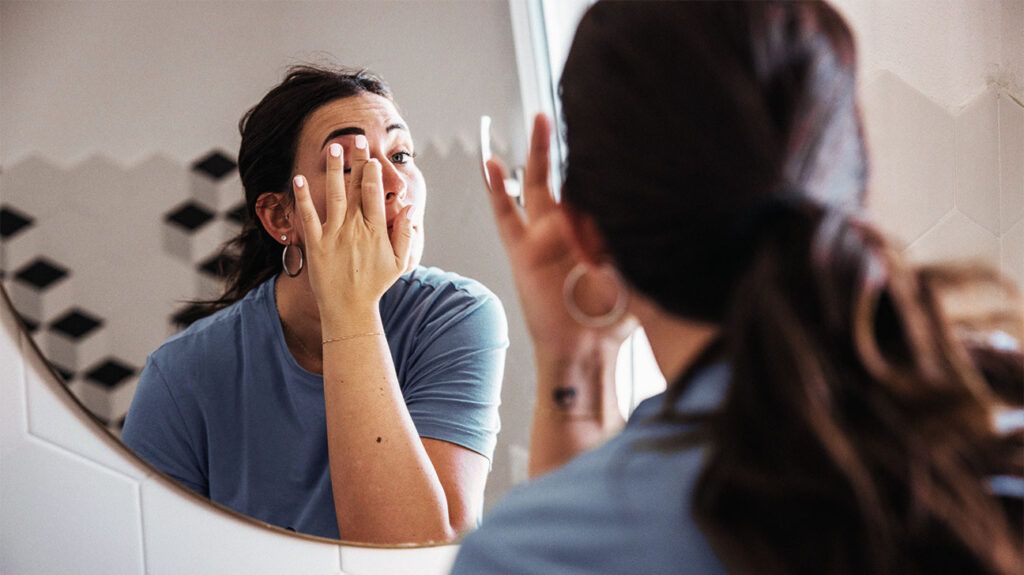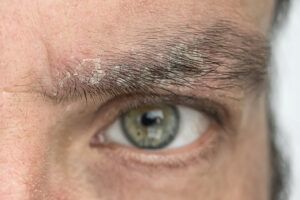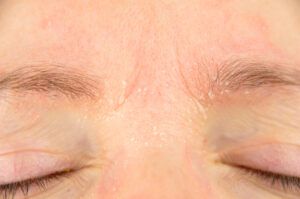Eyebrow dandruff is similar to dandruff on the scalp. It causes flaky skin to shed from the area and appear under, around, or between the eyebrows.
Eyebrow dandruff may have several different causes, including dry skin, seborrheic dermatitis, and contact dermatitis.
A doctor or dermatologist can help determine the cause of persistent symptoms and recommend treatment for the underlying issue.
In this article, learn more about the symptoms, treatments, and complications associated with eyebrow dandruff.

Some research suggests that dandruff may affect as much as
A person may have whitish, gray, or yellow flakes of skin under and around their eyebrows. The area may be flushed or inflamed, and a person may feel the need to itch or pick the area.
There are a few different causes of eyebrow dandruff, including:
Seborrheic dermatitis
Seborrheic dermatitis is a
A fungus called Malassezia may cause chronic seborrheic dermatitis. The fungus lives in the oily sebum of the skin and may multiply due to a poor immune system reaction. This can lead to chronic symptoms that require regular treatment.
Contact dermatitis
Contact dermatitis is a skin reaction to an allergen or irritant. The skin may react to an ingredient in products such as shampoo, conditioner, makeup, or the detergent a person uses on a hat or headscarf.
Contact dermatitis can cause an itchy, irritating rash in the area. The skin may flake off, causing dandruff. If eyebrow dandruff appears after using a new product, a person may wish to stop using it and talk with a dermatologist to undergo testing for any allergens.
Learn more about contact dermatitis.
Dry skin
Dry skin is a common cause of eyebrow dandruff.
People who live in harsh conditions or very low temperatures may get severely dry skin that leads to dandruff. This may go away quickly if the person moisturizes their face regularly.
Learn about remedies for dry skin on the face.
Eczema
Eczema is a chronic skin condition that causes inflammation and irritated patches of skin. It is possible for eczema to cause symptoms near the eyebrows.
Psoriasis
Psoriasis stems from an immune response that causes the skin to create new cells faster than the old cells can shed. This results in itchy scales or patches of skin.
Psoriasis may occur in many places on the body, including near the eyebrows, in some cases.
The best treatment option for eyebrow dandruff will depend on the cause. Moisturizing regularly can usually help.
The sections below outline some treatment options.
Over-the-counter treatments
Over-the-counter (OTC) products such as dandruff shampoos are a primary treatment for all forms of dandruff, including eyebrow dandruff.
Ingredients such as selenium sulfide and ketoconazole may help with dandruff and its underlying causes, such as excessive oil or fungal overgrowth in some cases.
Some other potentially helpful ingredients include:
- tar soap
- salicylic acid
- sulfur
- sulfacetamide
To use dandruff shampoo on the eyebrows, a person should lather the shampoo into the eyebrows and allow it to sit for a few minutes before rinsing it out. Try to avoid getting the lather in the eyes.
With contact dermatitis, using an OTC anti-itch cream or antihistamine drug can help soothe the symptoms or prevent irritation and itchiness.
Medical treatments
In some cases, it may be necessary to see a dermatologist to receive prescription-strength drug treatment.
If OTC anti-dandruff options do not result in improvement, it may be best to see a dermatologist for a stronger solution. They may recommend prescription-strength shampoo treatments containing compounds such as ketoconazole or selenium sulfide. These are similar to the OTC versions but have higher strengths.
Some home remedies may help treat mild cases of eyebrow dandruff.
However, even with natural products, skin reactions are possible. For this reason, it is important to test the product on a small area of skin before applying it to the face.
For mild cases of dry skin, natural oils such as coconut, avocado, or jojoba oil may help moisturize the face.
Tea tree oil is a widely available essential oil with some medicinal properties. In fact, one study suggests that tea tree oil has strong antifungal and antioxidant properties.
It is important to dilute the oil in a carrier oil. Also, take extra care when using tea tree oil anywhere near the eyes.
Anyone who is uncertain should talk with a dermatologist before using tea tree oil.
Although it may not be possible to prevent every case of eyebrow dandruff, some general tips may help reduce its likelihood.
Try:
- wearing protective clothing in harsh weather
- hydrating the skin using a facial moisturizer
- using sunscreen to protect the skin from the sun’s rays
- keeping track of potential allergens to stop using them
- not picking or touching the area
- tracking and avoiding potential irritants
There may be some complications associated with eyebrow dandruff, especially if a person does not seek treatment for it.
For example, seborrheic dermatitis can be a recurring, chronic issue for some people. Without treatment, the symptoms may be more difficult to control or get worse.
Also, there may be some long-term repercussions in the area, such as scarring from a severe reaction. A person may lose some hair or have thin eyebrows, depending on the underlying issue and how it affects the hair follicles.
Although the occasional case of dryness on the face is not usually a cause for concern, anyone worried about symptoms such as eyebrow dandruff should see a doctor or dermatologist.
Getting a diagnosis may help people start treatment that addresses the underlying cause of the dandruff.
Eyebrow dandruff is a common issue, and the treatment will depend on the underlying cause. Some causes are chronic and require regular treatment.
At other times, an allergen or harsh conditions may cause eyebrow dandruff. In these cases, it may improve with OTC treatment and avoidance of potential irritants.
If symptoms persist, it is important to talk with a dermatologist. They can help diagnose the underlying issue and recommend prescription-strength options to control or treat the symptoms.




